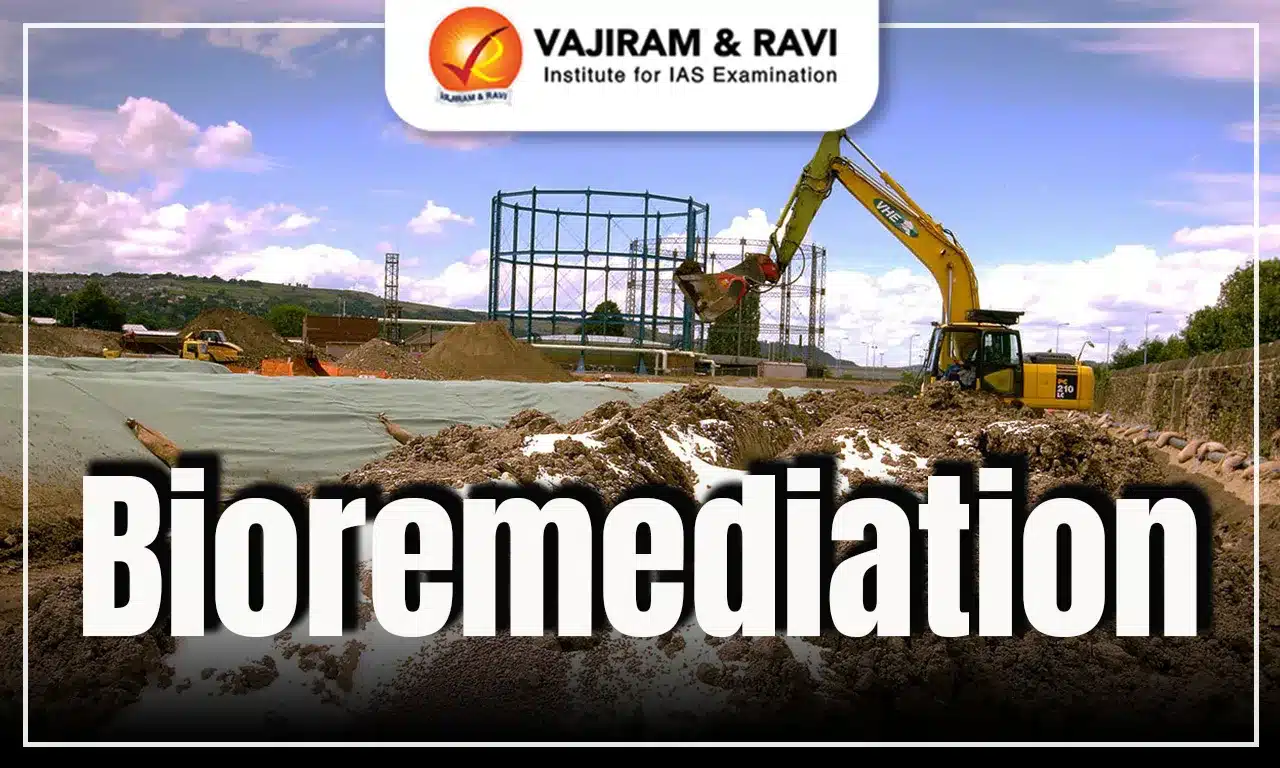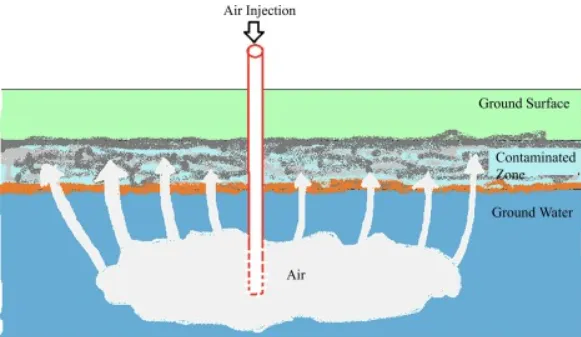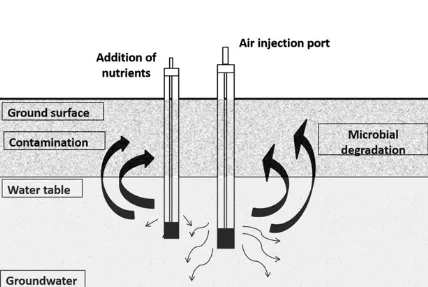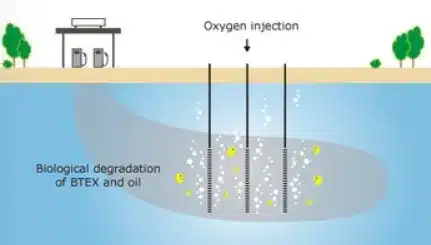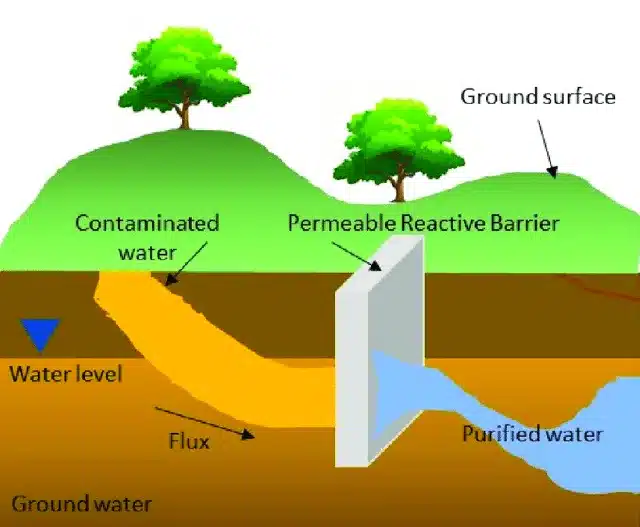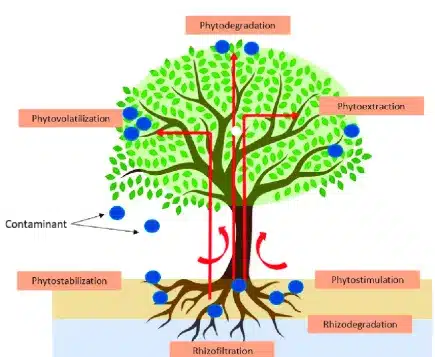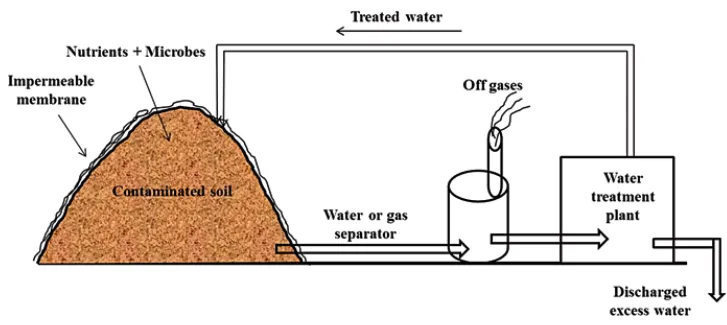Bioremediation is an eco-friendly method that uses microorganisms to treat contaminated soil, water, and waste. It includes two main types: in-situ, where pollutants are treated directly at the site using methods like bioventing and biosparging, and ex-situ, where contaminated materials are treated off-site using techniques like biofiltration and biopiles.
Applications of bioremediation range from cleaning heavy metals and hydrocarbons to addressing oil spills and agricultural byproducts. Bioremediation is cost-effective, promotes soil conservation, and reduces toxicity. However, challenges include slow processing times, environmental dependencies, and potential toxicity of by-products, which limit its wider adoption in many cleanup projects.
Bioremediation Meaning
Bioremediation is an environmental process that cleans up contaminated soil and groundwater. These microbes, including bacteria, are naturally found in the environment. By promoting the growth of specific microbes, bioremediation allows them to break down and consume contaminants as a source of energy and nutrients. This process effectively treats pollutants like oil, petroleum products, solvents, and pesticides.
Bioremediation Types
Bioremediation is categorized into two main types, based on the location where the remediation process occurs. Depending on the method used, bioremediation can either take place in situ (at the site of contamination) or ex situ (away from the site of contamination).
In Situ Bioremediation
In situ bioremediation occurs directly at the contamination site, whether treating polluted soil without excavation or addressing contaminated groundwater at its source. This method is preferred due to reduced labour and the lower risk of spreading pollutants by avoiding off-site transport.
- Key techniques in In situ bioremediation include bioventing, biosparging, bioaugmentation, bio attenuation, biostimulation, bio slurping, composting, and bioremediation.
Ex Situ Bioremediation
Ex situ bioremediation involves removing contaminated materials from their original location and transporting them to a separate treatment site. This approach is less frequently used, as it typically requires the excavation of polluted soil and its transport off-site.
- In the case of contaminated water, ex situ methods are uncommon, except for pumping groundwater to the surface for treatment in a controlled reservoir.
- However, ex situ bioremediation carries potential risks, such as the possibility of spreading contaminants or accidental spills during transport.
Bioremediation Examples
Examples of In-situ bioremediation include bio-venting and bio-sparging, which enhance microbial activity at the site to break down contaminants in soil and groundwater. Other methods such as bioaugmentation, bio-attenuation, bio-stimulation, and bio-slurping also aid in pollutant degradation.
Examples of Ex-situ bioremediation involve removing contaminated material for treatment offsite, using techniques like biofiltration, biopiles, bioreactors, land farming, and composting, where environmental factors such as temperature and nutrients are carefully controlled to optimize pollutant breakdown.
In Situ Bioremediation Technique
In-situ bioremediation involves treating contaminated soil and groundwater directly at the site using natural or enhanced microbial processes. Techniques like bio-venting, bio-sparging, bioaugmentation, bio-attenuation, biostimulation, and bio-slurping aim to accelerate the microbial degradation of pollutants. The detailed explanation is given below:
- Bioventing: It’s the most widely used method, involving small-diameter wells to introduce air into the soil, promoting microbial activity. It regulates oxygen and nutrients to address both soil and groundwater contamination.
- Biosparging: Air is injected at high pressure beneath the groundwater table to increase oxygen levels, which accelerates microbial degradation of pollutants. This method is a cost-effective alternative to excavation and treatment.
- Bioaugmentation: The industries introduce additional microorganisms, either native or non-native, to contaminated sites. This method is often combined with bio-venting and bio-sparging to enhance remediation efforts.
- Its effectiveness can be limited if non-native microbes do not integrate well with the existing microbial community, so it's important to select microbes that complement the natural bacteria present.
- Bioattenuation: Also known as natural bioremediation, it uses existing microbial activity to degrade pollutants, especially effective for fuel contaminants like BTEX (Benzene, Toluene, Ethylbenzene, and Xylene). It's low-cost but can be limited by site conditions and nutrient availability.
- Biostimulation: It accelerates microbial degradation of pollutants by supplying nutrients like nitrogen and phosphorus in specific ratios, along with other factors such as temperature, pH, and oxygen availability.
- Nutrient formulations must be tailored to the pollutant and site conditions for effective remediation. Studies show that changes in nutrient ratios can impact both microbial communities and hydrocarbon degradation rates.
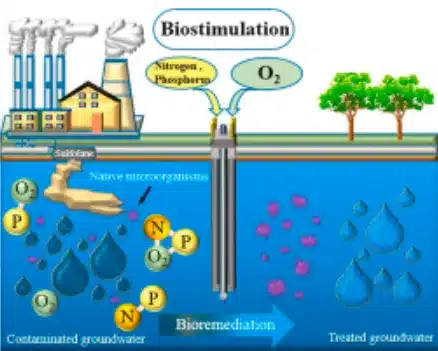
- Bioslurping: It combines vacuum-enhanced pumping, soil vapour extraction, and bio-venting to remediate soil and groundwater by promoting oxygen flow and contaminant biodegradation.
- It targets light non-aqueous phase liquids (LNAPLs), operating like a straw to extract liquids. While effective in high-permeability soils, its limitations include reduced microbial activity in moist soil and challenges with fluctuating water tables.
- Phytoremediation: Microbe-assisted phytoremediation enhances pollutant degradation by combining plant and microbial interactions. Plants promote the breakdown of contaminants through processes like phytodegradation, phytoextraction, and phytostabilization.
- Microbes in the rhizosphere aid in this degradation, with pollutant-degrading endophytes offering potential benefits.
- However, challenges include pollutant hydrophobicity, plant stress, and limited microbial activity in subsurface areas, impacting remediation efficiency.
Ex Situ Bioremediation Technique
Ex-situ bioremediation involves the removal of contaminated soil or water from a site for treatment in a controlled environment using methods such as biofiltration, biopiles, bioreactors, land-farming, and composting. These techniques allow for precise control of environmental factors, optimizing pollutant breakdown.
- Biofiltration: It is a biological method for treating biodegradable waste, using microbial populations to break down contaminants. It purifies air contaminated with volatile organic compounds through materials like bio-filters, bio-trickling filters, bio-scrubbers, and conventional bio-filters.
- These filters, often made of compost, soil, or peat, allow pollutants to interact with microorganisms and be biodegraded.
- Biopile: Biopiles are an above-ground bioremediation method that treats contaminated soil by enhancing microbial activity with added nutrients, aeration, leachate collection, and a treatment bed.
- This process accelerates biodegradation by controlling temperature, moisture, and airflow. It is effective for various pollutants, adaptable to harsh environments, and scalable for large areas.
- However, challenges include soil drying from excessive heating, high maintenance costs, and the need for a reliable power supply in remote areas. Despite these, bio-piles are space-efficient and effective for large-scale soil treatment.
- Bioreactor: A bioreactor is a vessel designed for bioremediation by facilitating biological reactions to convert raw materials into specific products. It allows for precise control of factors like temperature, pH, and nutrients, optimizing pollutant breakdown.
- While highly efficient, bioreactor-based bioremediation can be costly, labour intensive, and difficult to scale due to the need to manage multiple parameters and transport contaminated materials.
- Land Farming: It is a simple, low-cost bioremediation technique that enhances the natural breakdown of pollutants, particularly hydrocarbons, through aeration, nutrient addition, and irrigation. Depending on the depth of contamination, it can be done in situ or ex-situ.
- While it is effective for treating large volumes of soil, it requires ample space and struggles with inorganic pollutants and volatile toxins, especially in warmer climates, making it less efficient in some cases.
- Composting: It reduces waste volume, eliminates pathogens, and degrades organic pollutants in contaminated soils. It can enhance bioremediation by adding composted material or directly composting polluted soils.
- Composting improves soil structure and nutrient status, but challenges remain in understanding microbial roles during different stages and managing the fate of nonextractable pollutant residues.
Bioremediation Applications
Bioremediation applications utilize microorganisms and natural processes to address environmental challenges, including removing toxic heavy metals, degrading hydrocarbons in soils, cleaning up marine oil spills, treating rubber waste, and remediating agricultural byproducts for sustainable pollution control.
- Heavy Metal Bioremediation: Bioremediation utilizes various methods, including microorganisms like Pseudomonas putida, Escherichia coli, and algae such as Chlorella vulgaris, to remove toxic heavy metals (lead, cadmium, chromium, copper) through degradation, absorption, and detoxification.
- Soil Bioremediation: This approach uses bacteria, fungi, and other biological processes to degrade hydrocarbons in soils contaminated with oil and petroleum products, maintaining soil health and promoting natural recovery.
- Marine Oil Spill Bioremediation: Bioremediation of oil spills involves natural and tailored techniques like the application of indigenous oil-degrading microorganisms (Halomonas aquamarina, Alcanivorax) to break down oil, offering an eco-friendly alternative to chemical cleaners.
- Rubber Waste Bioremediation: Bioremediation of rubber waste includes microbial treatments like Pseudomonas sp., which reduce pollutants such as BOD, COD, and solids, alongside sulfur removal and rubber degradation for recycling.
- Agricultural Waste Bioremediation: Agricultural waste materials (e.g., food, agroindustrial residues) are used for heavy metal remediation due to their chemical composition and capacity for metal chelation, adsorption, and complexation, offering an eco-friendly solution for environmental cleanup.
Bioremediation Advantages
Bioremediation is a sustainable, cost-efficient approach that harnesses natural processes to treat contaminants directly at the site. It minimizes waste and emissions while promoting soil conservation.
- Eco-friendly and Affordable: Bioremediation is a sustainable and cost-effective alternative to conventional cleanup methods.
- In-situ Treatment: It treats contaminants directly at the site, using natural processes, with lower operational costs.
- Efficient and Low-Waste: This breaks down pollutants faster than natural processes, creating minimal emissions and secondary waste.
- Soil Conservation: Cleans the soil without needing to remove it, preserving its structure and usability.
- Toxicity Reduction: Converts harmful contaminants into less toxic forms, speeding up their natural degradation.
- Ecosystem Restoration: Encourages plant growth and natural habitat recovery, promoting long-term environmental health.
Bioremediation Disadvantages
Bioremediation faces several challenges, including its dependence on environmental factors and slow processing times. Additionally, regulatory uncertainty and the potential toxicity of degradation by-products limit its widespread application.
- Environmental Dependency: Bioremediation relies on optimal conditions like temperature, pH, and moisture to support microbial growth, which may vary significantly between sites.
- Specific Contaminant: It works best for moderately hydrophobic contaminants, and certain pollutants may require specific microbial strains for effective degradation.
- Time-Consuming Process: Bioremediation often takes longer than mechanical treatments like soil excavation or incineration, making it less suitable for urgent cleanup efforts.
- Mass Transfer Limitations: Bioremediation is limited in its ability to treat deep soils, groundwater, and complex mixtures of contaminants, especially when unevenly dispersed.
- Regulatory Uncertainty: There is no clear regulatory framework or performance criteria for bioremediation, adding uncertainty to its application and acceptance.
Bioremediation UPSC PYQs
Q1. In the context of solving pollution problems, what is/are the advantage/advantages of bioremediation techniques? (UPSC Prelims 2017)
- It is a technique for cleaning up pollution by enhancing the same biodegradation process that occurs in nature.
- Any contaminant with heavy metals such as cadmium and lead can be readily and completely treated by bioremediation using microorganisms
- Genetic engineering can be used to create microorganisms specifically designed for bioremediation
Select the correct answer using the codes given below
(a) 1 only
(b) 2 and 3 only
(c) 1 and 3 only
(d) 1, 2 and
Ans. (c)
Last updated on December, 2025
→ Check out the latest UPSC Syllabus 2026 here.
→ Join Vajiram & Ravi’s Interview Guidance Programme for expert help to crack your final UPSC stage.
→ UPSC Mains Result 2025 is now out.
→ UPSC Notification 2026 is scheduled to be released on January 14, 2026.
→ UPSC Calendar 2026 is released on 15th May, 2025.
→ The UPSC Vacancy 2025 were released 1129, out of which 979 were for UPSC CSE and remaining 150 are for UPSC IFoS.
→ UPSC Prelims 2026 will be conducted on 24th May, 2026 & UPSC Mains 2026 will be conducted on 21st August 2026.
→ The UPSC Selection Process is of 3 stages-Prelims, Mains and Interview.
→ UPSC Result 2024 is released with latest UPSC Marksheet 2024. Check Now!
→ UPSC Prelims Result 2025 is out now for the CSE held on 25 May 2025.
→ UPSC Toppers List 2024 is released now. Shakti Dubey is UPSC AIR 1 2024 Topper.
→ UPSC Prelims Question Paper 2025 and Unofficial Prelims Answer Key 2025 are available now.
→ UPSC Mains Question Paper 2025 is out for Essay, GS 1, 2, 3 & GS 4.
→ UPSC Mains Indian Language Question Paper 2025 is now out.
→ UPSC Mains Optional Question Paper 2025 is now out.
→ Also check Best IAS Coaching in Delhi
Bioremediation FAQs
Q1. What is bioremediation?+
Q2. What are the three types of bioremediation?+
Q3. What are the objectives of bioremediation?+
Q4. What is the process of bioremediation?+
Q5. Which bacteria are used for bioremediation?+
Tags: bioremediation quest UPSC Environment and Ecology Notes



